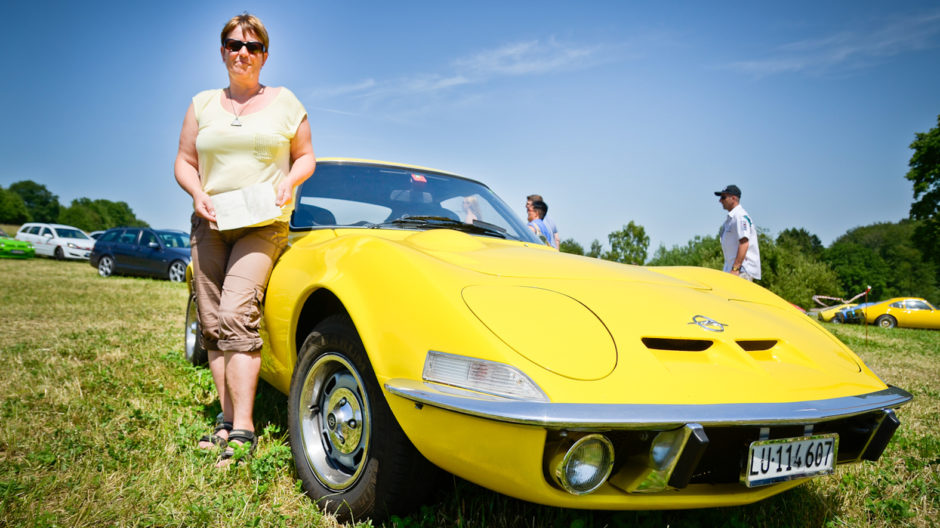- What’s it like to love the GT? When did love blossom and how has it changed over the years? Visitors to the 2014 European Opel GT Meet share their thoughts and memories. First up is …
- … Jürgen Hofmann with his white GT 1900: “The GT was my first car back in 1985. It wasn’t exactly the norm for a new driver to have a car like that. Your first car is usually cheap and has a tiny engine. My buddies had Kadetts with 45 hp. What I really wanted was to ride a motorcycle. But then I saw this red car beside a Manta B at the gas station. I was 17 and …
- … had a moped at the time. I didn’t know what that car was, but I definitely knew that I wanted one. I looked in the paper and found an ad that summed it up in five words: GT, white exterior, red interior. I bought that car and I still have it today. It’s not the one I brought with me, though. My first GT was a trusty companion in the 1980s. Those years were pretty wild for me. I modified my GT with everything that …
- … was available in those days: spoilers, rocker panel, side pipes, six cylinder engine. And it’s all still there. It belongs to the car and it’s a part of GT history. I found my second GT five years ago. It was built in 1969 and it hasn’t been restored at all, which is pretty rare – just like my first GT all those years ago. I simply had to get it.”
- Gerald and Uschi Weber are proud of their GT, too, a lilac-colored roadster. Gerald Weber says: “First off, as a young guy in 1985, I didn’t have a lot of money. Second, the GT was an awesome sports car. And finally, I never considered anything but an Opel. My father, mother, and brother were Opel employees, and I work there too, in drive system development. I bought the GT with my hard earned and hard saved money. It was affordable and I was immediately in love with its shape. I only …
- … have to look at those contours side-on and it makes me happy. I still remember how much I paid for it: 5,600 German marks for a 14-year old car. The first serious reconstruction efforts started fairly soon. It added all that stuff that when you look at it today, you just think: For goodness’ sake! Anyone buying a GT now is looking for original quality, maybe even as an investment. But back then, it was all about colors and a lot of plastic. I completely restored the car in 1991. I worked on it every day for two years. It originally had …
- … a 1.9-liter engine, but I upgraded it to a 2.4-liter engine and took off the roof. I once saw a GT convertible and I spent many nights thinking about how that could be done, and if it was even possible. At that time, the GT Club in Rüsselsheim was running a workshop space and everyone used to help each other out. My wife helped with the color and designed the interior.”
- Marco Lana was there too with his 1969 GT with a tow bar: “I bought this silver GT 13 years ago. It’s my third Opel GT, and I’m never getting rid of it. My history with the GT started 20 years ago. I found a disassembled GT and I thought I could put it back together. But when I looked at photos of other GTs to see if I was on the right track, I always noticed big differences. I asked myself: Why does everything look so different on this one? There were two major reasons for this. First of all, mine was fitted with …
- … a rear axle from a Jaguar and a six cylinder engine, and secondly, it had no partition wall. So it never worked out. That’s when I moved on to my second GT. It came from America and it really was a beauty. There was no rust, but I soon discovered that it had a lot of spackle. The car …
- … had been involved in an accident and was patched up very superficially, so I didn’t end up keeping it. So, on to number three. I worked with a car painter for three years to get the body into shape. He helped me out and I helped him out. Over time, we fitted the GT with 16-inch rims from Borbet, air conditioning …
- … from a small Japanese car, Recaro bucket seats with real leather, and electronic power steering. And, of course, the tow bar. But what I like more than anything else is when I see other people admiring my GT. It’s great to get a thumbs up and a smile just because of a car.”
- Wolfgang Gespann and his 1-liter GT from 1973: “I love it just as much as I did on the day that I got it. It’s because it’s affordable and constructed with mass-production parts. But it still has so much flair. I was a photographer in the plant when it was designed. When it was first unveiled, I took a lot of press photographs, often with professional models. It didn’t always work out as planned. If there was no model available, my wife had to step in. She ended up being on the front page of a few magazines with the GT.”
- Olaf Moldzen and his Sport-GT/J model from 1971: “I’ve had 50 GTs over the past 25 years. I own five at the moment, and I’m keeping all of them. A lot of people on the scene have more than one GT because they are so obsessed with the car. The yellow GT with me here today is my …
- … favorite. It’s a GT/J that I converted into a sports and rec vehicle using Irmscher parts. I drive it on vacation and over mountain passes, and I use it for mountain rallies and on the race track from time to time. The engine has a capacity of 2.2 liters, sharp camshafts, two Weber carburetors, and it puts out around 165 hp. Soccer player Manni ‘Banana Crosses’ Kaltz was the first owner of this car. He drove it during his first year as a professional player for the Hamburg SV club.”
- Brigitte Muggli from Lucerne, Switzerland, and her yellow GT 1100: “I call it my pearl. It’s the car that’s the pearl, not me. When I was young, I used to say to myself that I’d have a car like that some day. It took a long time until I made my dream come true. The 2011 European Meet was held in Hochdorf in Switzerland, and someone from the Valais region wanted …
- … to sell a 1.1-liter engine GT. Two Germans were interested in buying it, but they didn’t make up their minds quickly enough. After the Meet, I wrote to the seller and told him I could make a down payment on the spot and that I wanted that GT – it was now or never. So the car ended up staying in Switzerland. The two Germans have since …
- … become good GT buddies of mine. That’s almost as great as the car itself. GT drivers are awesome people. I can’t put into words all the things I have experienced with my GT over the past three years. My husband thinks its small engine is too slow, but I …
- … love it. It runs like a Swiss clock. I only had to tinker around with one thing: I had to extend the seat rail to the front because my legs are so short.”
- The next generation: Jonas is still more interested in his stroller, but if things go on like this, he’ll soon be making off with the 1969 GT AL of his parents Sandra and Matthias.
- Katharina, Ben, and Snoopy didn’t come in a GT; they came in Katharina’s Manta B. Snoopy needs the space – he likes to sit in the back and stick his head out the window and enjoy the breeze.
- Markus and Holger from opel-models.de simply love Opels. They build remote-controlled Opel model cars. Their standard 30 km/h models with Lexan chassis cost €199; speed kits for up to 70 km/h cost an additional €99. Markus and Holger also take special orders.
There’s that black lever. It looms out from the center console in front of the gearshift like a second brake lever built in the wrong way around. It only grabs your attention due to its size. Tilting the lever forwards triggers two rotational motions at the front the fenders. Quickly, simultaneously, and with a short ‘clack,’ the GT opens its eyes. They bulge out to the left and right of the car’s flat snout like two guide marks to navigate the roads. They take us around Lautertal, through quaint villages, and through the early summer shades of green of the Odenwald forest. Here, the harsh sunshine pierces the dark pine and fir trees and the leafy canopy created by the oaks and beeches
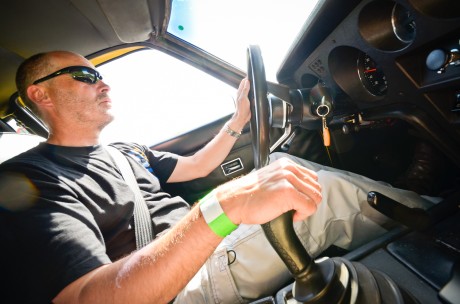
Olaf Moldzen: “It’s hard to describe that feeling you get from the GT. It’s something really special.”
IF ONLY IT COULD GO ON LIKE THIS FOREVER The light runs over the cars in front for a moment before scurrying between the extended headlights and over the long hood of Olaf Moldzen’s Opel GT, briefly hitting the curved windshield and then disappearing over the arc of the roof and the fender, and finally touching the street behind the cut-off rear section with its four round taillights. Cool air wafts in through the open window on this warm Sunday morning. Together with the typical Opel gray-cast iron grumbling, in the narrow interior of the GT, this causes a growing desire: If only it could go on like this forever.
MORE THAN JUST A CAR
Olaf gently shifts down a gear before the next bend, steers towards the apex, and smiles from ear to ear. He’s in the zone. “It’s hard to describe that feeling you get from the GT. It’s something really special.” That it is. Opel advertising texts once summed up the GT driving experience with the words: ‘It’s the next best thing to flying,’ which soon became common parlance. But the ads back then were lying. Or then again, maybe they weren’t. The saying was coined by advertising legend Carolus Horn, and while it did get to the heart of the matter, flying wasn’t actually any better or more exciting than driving a GT. The GT represents a feeling, and it’s much more than just a car. If you view it as a car alone, you’d say it was cramped and impractical, as it only has two seats and no hatch.
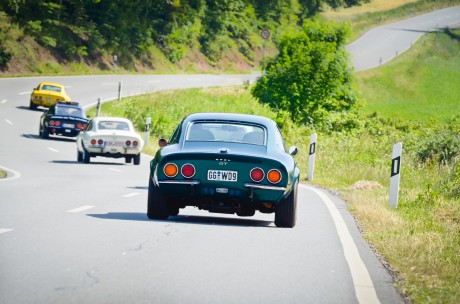
Opel advertising texts once summed up the GT driving experience with the words: ‘It’s the next best thing to flying,’ which soon became common parlance.
THIS CAR CAPTURED THE SPIRIT OF THE TIME AND GAVE IT A FACE
Anyone who has driven the GT for just a single kilometer knows that it’s more than just a car. They know that driving a GT really is superior to flying. This fact is clear to everyone at the 22nd European GT Meet. Some came from northern German towns like Stade or Heide, while others traveled from the depths of Bavaria or the Black Forest. Some of the guests at the Kuralpe lodge in Lautertal are locals, others came from as far afield as the Netherlands, Switzerland, or Austria. “We’ve got about 200 GTs here,” says HG from the GT Bergstrasse club. He doesn’t like his name, “which is why he always introduces himself as HG,” says fellow club member Martin Wiesenfahrt. Wiesenfahrt estimates that around 400 people have come together for this year’s European GT Meet. “That’s not including day visitors, but it’s impossible to keep track of those.” It’s easy to count the new GTs, which are allowed at the GT Meet for the first time this year. There are just four of them, and they quickly get lost among the many older GTs. With these cars, Opel not only captured the spirit of the late 1960s, it also helped shape the times through the face of the GT. The GT contours have inspired car makers for decades, and the charismatic GT remains irresistible to this day.
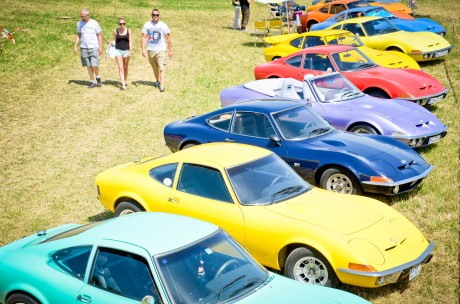
IS IT THE MOST BEAUTIFUL? THE MOST GLAMOROUS? THE MOST EXTRAVAGANT AND THE BOLDEST?
It goes without saying that it’s unique. The GT didn’t have a predecessor or a direct successor. It quickly acquired a cult following. And it’s still the best proof that Opel never matched the image that Spiegel magazine tried to pigeon-hole it with in the 1970s. At the time, the magazine wrote that typical Opel drivers were “plump and without ambition, prone to sitting behind the wheel wearing a hat and work clothes while sucking on a cheap cigar.” Looking at the individual groups gathering and taking up positions behind the lead vehicles for the drive through the Odenwald forest, there were no drivers wearing work pants or smoking cigars in sight. Those wearing hats did so for protection from the blazing sunshine. Many visitors took it easy in the shaded beer garden of the lodge, or they hid from the sun under the marquees to chat about fuel and all sorts of things. The party went late into the night, and today, everyone is taking a while to get going again.
THEY’VE ALREADY STARTED UP THE BARBECUE NEXT DOOR
Markus and Holger from opel-models.de dust off the display case containing their remote-controlled Opel model cars. A boy has fun putting one of the specially-designed GT toy cars through its paces along an obstacle course. There’s already smells wafting over from the barbecue next door. The only way to keep a stump-tailed Labrador away from the sausages and meat loaf is through stern words and frantic tugging on its leash. There’s something for everyone at the GT Meet, be it from the grill or from Opel. The Jumpstart initiative, for example, made it its mission to bring both existing Aero GTs to Lautertal. Charles M. Jordan’s design team created a Targa version of the GT with a roof bar and a steeply positioned retractable rear window for the 1969 Frankfurt Motor Show. A second model in metallic blue was built by Michelotti in the spring of 1970. Sadly, these two specimens were the only ones ever made. Still, the GT was a much more successful model than initially expected.
German automobile magazine Auto Motor Und Sport described the GT as “the sportiest car you could ever imagine” when it debuted in 1968. Yet hardly anyone had thought serial production was on the cards after the ‘Experimental GT’ study presented at the Frankfurt Motor Show three years prior. It was a well-liked prototype, but would it ever make it? Well, it did make it. Opel built 103,463 GTs between October 1968 and June 1973. Because Opel was not in a position to expand its own capacities quickly enough, the chassis were manufactured by Chausson in Gennevilliers and painted by Brissonneau et Lotz, also in France. Engineering work on the GT was then carried out in Bochum. The floor assembly, undercarriage, and 1.1-liter engine, which was available in the GT until 1970, were all sourced from the Kadett B; the 90-hp 1.9-litre four-cylinder engine comes from the Rekord C. Over 90 percent of GTs ended up being fitted with the 1.9-liter engine.
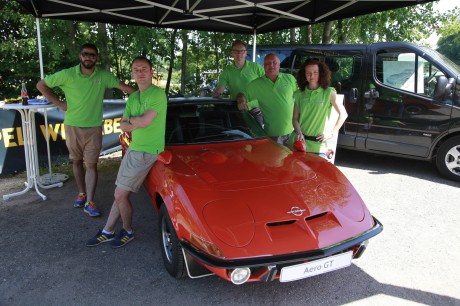
The Jumpstart initiative managed to bring both Aero GTs to Lautertal.
11,880 GERMAN MARKS BACK THEN, UP TO €20,000 NOW
Opel sold over three quarters of its GTs outside of Germany. More than half went to the U.S., often equipped with a three-gear automatic transmission. When production first started, you could buy a GT for 11,880 German marks. Today, you might pay up to €20,000 for a GT 1900 in good condition. True fans of the Opel GT would never part ways with their car for money, though. It’s their dream, a purpose in life and often considered a member of the family. It’s their quirk, the embodiment of their inner daredevil. If you’re not careful, you too will soon be infected by the Opel GT virus. All it takes is a few kilometers before you want to reach for that lever in the center console.
